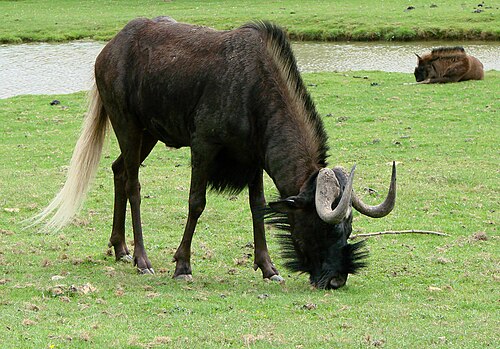Latest revision as of 09:59, 4 April 2021
Information about message (contribute ) This message has no documentation.
If you know where or how this message is used, you can help other translators by adding documentation to this message.
Message definition (AY Honors/Antelopes - Advanced/Answer Key )
</noinclude>
</noinclude>
<!-- 4. Which large antelope differs from most of the others in appearance? What are some of its peculiar habits? -->
[[Image:Gnou Thoiry 19803.jpg|thumb|450px|The ''wildebeest'', also known as the ''gnu''.]]
The wildebeest is the most unique looking antelope. It has a beefy muscular front-heavy appearance with a distinctive robust muzzle, it strides with relatively slender legs and moves gracefully and quietly most of the time, belying the reputation for stampeding in herds; however the stampeding characteristic may sometimes be observed. Probably the most conspicuous feature of the Blue Wildebeest are the large horns shaped like parentheses, extending outward to the side and then curving up and inward. The manes appear long, stiff, thick and jet black, a color assumed by the tail and face as well. The
wildebeest , also known as the
gnu .
The wildebeest is the most unique looking antelope. It has a beefy muscular front-heavy appearance with a distinctive robust muzzle, it strides with relatively slender legs and moves gracefully and quietly most of the time, belying the reputation for stampeding in herds; however the stampeding characteristic may sometimes be observed. Probably the most conspicuous feature of the Blue Wildebeest are the large horns shaped like parentheses, extending outward to the side and then curving up and inward. The manes appear long, stiff, thick and jet black, a color assumed by the tail and face as well.

